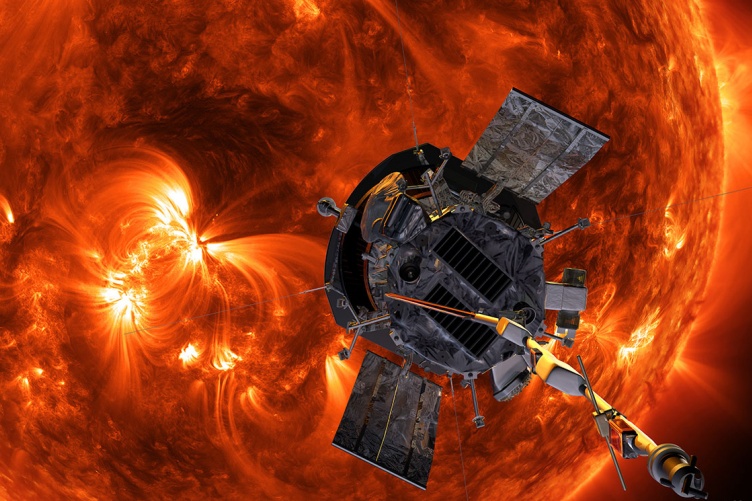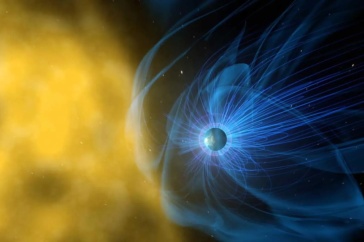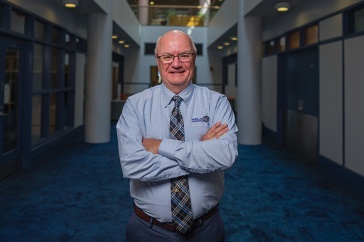
The Parker Solar Probe Illustration: NASA/Johns Hopkins APL/Steve Gribben
As the data from NASA’s Parker Solar Probe (PSP) begin to pour in, UNH researchers are gaining a flurry of insights about the activity coming from our closest star.
The newest data show how plasma released after a solar flare — a sudden flash of increased brightness — can accelerate energetic particles and cause them to pile up, which generates large numbers of particles that become highly energized. These high-energy particles, moving almost at the speed of light, create dangerous radiation conditions that can disrupt electronics and satellites in space, and cause harm to spacecrafts and astronauts.
“These events challenge our understanding of how particles are energized and transported both close to the sun and further out in the inner solar system.”
“We’re getting some of the earliest observations from this mission to the sun on how the coronal mass ejections — the sun’s release of plasma and energy — build up particles released after solar flare events,” said Nathan Schwadron, professor of physics in UNH’s Space Science Center. “Because energetic particles are accelerated near the sun, by flying closer and getting a better look we are able to observe the beginning of the energization process and see them actually start to pile up like snow that piles up in front of a snowplow. Instead of an actual snowplow, it is the coronal mass ejections released from the sun that cause the buildup of this material in space.”
Schwadron’s research, published in Astrophysical Journal Supplement Series, is based on data from the Integrated Science Investigation of the Sun (ISOIS), one of four scientific instruments aboard the PSP. ISOIS focuses on the particles that are energized and fly faster than the solar wind. By flying the PSP close to the sun to learn more about how these particles move, scientists hope to improve space weather forecasts to better protect technology and human health.
ISOIS has provided additional recent insights: Schwadron was involved in another study published in Nature that indicates high-energy particles coming from the sun are more varied and numerous than previously thought. Taken together, the results of both studies provide a unique look at how these particles become so fast moving and what causes their speed to accelerate.
“We had to go close to the sun to discover the large variation of energetic particle events it produces,” Schwadron says. “These events challenge our understanding of how particles are energized and transported both close to the sun and further out in the inner solar system.”
UNH is involved in other aspects of the PSP missions as well; Ben Chandran, professor of physics in UNH’s Space Science Center and the Department of Physics and Astronomy, assists with the Electromagnetic Fields Investigation (FIELDS) instrument and the Solar Wind Electrons Alphas and Protons (SWEAP) experiment on board. In two other studies, also published in Nature, the FIELDS and SWEAP teams focused on “slow” solar wind — the charged particles that flow less than 500 km per second. FIELDS data indicate that the slow solar wind is emerging from holes in the sun’s corona — the outermost layer of the sun — located near its equator. To the team’s surprise, SWEAP data uncovered large rotational velocities in the near-sun solar wind, which may help scientists understand how the sun’s own rotational motion gradually slows down over time.
“One of the most exciting discoveries to come out of this early stage of the mission is the presence of large numbers of discontinuities in the interplanetary magnetic field close to the sun—that is, sudden jumps in the magnetic field direction,” Chandran explains. “In virtually every case, the jumps in magnetic field are accompanied by sudden jumps in the solar wind speed. We don’t yet understand what these discontinuities mean or how they arise, but they may hold an important clue into one of the main science goals of the mission: to understand how energy flows outward from the sun to power the solar wind.”
Preparing the Data for Primetime
Long before the public knows about the latest findings from the PSP, scientists — including some at UNH — spend months processing the raw data into a more user-friendly format. UNH serves as the Science Operations Center for the ISOIS instrument, where Jonathan Niehof, a research scientist in the Space Science Center, is leading the five-person ISOIS data processing team, which currently includes three UNH undergraduate students. Since the launch of the probe in August 2018 right up until the first public release of the data in November 2019, the team worked hard to wrangle the information and get it ready for scientists like Schwadron to then interpret.
“There is just so much data coming in that a lot of our work involves thinking about the best way to present the data to gain a better understanding of it,” Niehof says.
“There is just so much data coming in that a lot of our work involves thinking about the best way to present the data to gain a better understanding of it."
The data do not flow in on a constant basis; instead, NASA’s Deep Space Network downlinks the data in batches, transfers it to the missions operations center at the Johns Hopkins University Applied Physics Laboratory, which is then accessed by the UNH team. Many factors come into play just to be able to downlink the data, Niehof explains. The probe’s antenna needs to be aimed at the Earth for land-based computers to connect with the data, but while the probe is close to the sun, the heat shield needs to be positioned in a way that protects the instruments from the scorching temperatures. During this time, the PSP can’t turn to point its antenna at the Earth, so scientists have to wait.
The probe cannot simultaneously collect data and allow for a downlink due to power constraints, so scientists wait until after its close sun encounters to access the newly acquired information. Niehof says that there are two or three weeks after a sun fly-by when “the geometry is good for downlinking.”
Once all those pieces fall into place, the ISOIS data processing team can begin learning more about the high-energy particles that blast the instrument — including what types of particles they are, how many of them hit the probe, and what direction they come from. The team compares this detailed data to summary data collected by ISOIS. If any discrepancies arise between the two, they use software updates to make the necessary corrections in the data processing.
“For the last six months, we’ve mostly been dealing with the unexpected challenges that have come up in data processing,” Niehof says. “We know how things were supposed to go, but now we’re dealing with reality, and so we have to learn where to be flexible to make this all happen.”
The PSP will fly by the sun more than a dozen times in the coming years, so UNH researchers will be busy sorting through troves of data to learn even more about the sun’s activities and how they impact space weather — and ultimately, humans.
The Institute for the Study of Earth, Oceans, and Space (EOS) is UNH’s largest research enterprise, comprising six centers with a focus on interdisciplinary, high-impact research on Earth and climate systems, space science, the marine environment, seafloor mapping, and environmental acoustics. With more than $43 million in external funding secured annually, EOS fosters an intellectual and scientific environment that advances visionary scholarship and leadership in world-class research and graduate education.
-
Written By:
Rebecca Irelan | Institute for the Study of Earth, Oceans, and Space | rebecca.irelan@unh.edu | 603-862-0990

















































